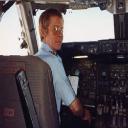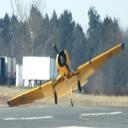Yahoo Answers is shutting down on May 4th, 2021 (Eastern Time) and the Yahoo Answers website is now in read-only mode. There will be no changes to other Yahoo properties or services, or your Yahoo account. You can find more information about the Yahoo Answers shutdown and how to download your data on this help page.
Trending News
How do planes navigate so they line up with the runway on landing?
You have a starting point (Airport A) and finishing point (Airport B). If you fly between them, there's no guarantee that you'll end up on a path directly in front of the runway when you go to land.
So I can imagine you'd need three navigation points, Airport A, the end of the runway at Airport B, and Turn Point C which a point in line with the runway some distance out.
But here's the question - if you start turning the plane at C you'd have to compensate for the speed of the plane and the rate of turn otherwise you'd not line up. So how do pilots account for this?
Always wondered ... thanks!
Andre - thanks for your answer. But the difference is I can see where my driveway is! How do they do it at night, with the runway miles away, covered in cloud? And suppose the air traffic controller says 'turn to a bearing of 223' ... well that takes time to relay the information. Then the pilot decides to turn the plane. Turn it too fast and you'll miss the runway. Turn it too slow and you'll miss the runway! How do you get the rate of turn correct?
I'd like to thank everyone for answering this question. Each answer added something to the others, and I wish I could share the best answer! It seems that its a combination of pilot experience in knowing how their aircraft behaves, mental skill in visualising where they are, visual cues, instrument systems, communication with the ground, etc. Must be a lot of work going on in the cockpit during the landing cycle! Thanks again.
8 Answers
- John RLv 75 years agoFavorite Answer
If they are in visual conditions, they look out the window. In instrument conditions they fly a published instrument approach (links to a couple follow)
Even airliners flying under instrument rules often fly visual approaches - some airports have "instrument" approaches that consist of following a river to the airport. This is often done for noise abatement. Reagan National is infamous for having a river approach that requires a turn at the last minute to line up with the runway.
http://155.178.201.160/d-tpp/1605/00443RIVER_VIS19...
Under actual instrument conditions, the approach course is defined by some type of navigational aid: an ILS (instrument landing system), a VOR, or a GPS course. During an instrument approach, the plane is lined up on the the approach course several miles from the airport - once on the approach course, the pilot flies the approach by instrument, ATC does not provide steering or vectoring.
There are 2 or 3 types of approaches that may be possible, depending on the nav aid being used:
A precision approach that provides a glide slope as well as runway alignment. These have the lowest visibility requirements, and some airplanes can even use it to auto land at some airports.
http://155.178.201.160/d-tpp/1605/00528IL24.PDF
A non - precision approach lines you up with the runway, but does not provide a glideslope, just a minimum altitude you can safely descend to. If you are at the MDA, and reach the missed approach point without seeing the airport, you have to fly a missed approach and try again (or go where the weather is better).
http://155.178.201.160/d-tpp/1605/00528V24.PDF
There are also circle to land approaches, where the instrument approach only brings you to the vicinity of the airport, and from there you join a visual landing pattern. Approaches that are only circle to land have a letter in the name, rather than a runway number. (VOR 24 would be an approach to runway 24, VOR A would be a circle to land approach)
http://155.178.201.160/d-tpp/1605/06284RB.PDF
An ILS can be flown as a non-precision approach if the glide slope is not available, and any approach can be flown as a circle to land. Let's say the weather's not too bad, but the wind is blowing the wrong way to land safely on runway 24, but the only instrument is an approach to runway 24. You can fly that approach to the "circling" mimimum altitude, then fly a landing pattern to land on Runway 6, or any other runway.
- ?Lv 65 years ago
The simple answer is that traditionally there is a radio signal at the airport that defines not just a point to navigate to, but a line to follow as you approach the runway. Airplanes have an instrument that tells the pilot if he/she is on the line or off to which side and by how far. The air traffic controller can guide the pilot to intercept that line at a convenient point and at a shallow angle to make following it easy. Also, when following ATC instructions, all turns are done at a standardized rate of 3 degrees per second so that it is predictable to ATC and easy for them to manage.
The above is referring to horizontal navigation. There is another signal that does all of the same things, except for vertical guidance along a glide slope so the pilot will reach ground level at the correct place.
Some airplanes are able to follow these signals automatically without the pilot managing the flight controls.
Of course with modern GPS, these ground radio signals are less necessary.
- Rona LachatLv 75 years ago
I can see where my driveway is! Very Nice now will and 18 wheeler proceed exactly the same way on the same road to park in your driveway too. A Motorbike?
When you are driving your car and come to a Freeway interchange how do you make a turn?
Do you do it exactly the same as every other vehicle on the same road.?
The plane does not have to go in straight lines the entire distance. Many small course corrections along the way
Just like you in your car make a slight wheel adjustment when you turn to keep in the centre of your lane.at the end of your turn.
How do you get the rate of turn correct? Some reason you do not think that after the big turn that the pilot cannot make many smaller ones to get lined up.
How do they do it at night, with the runway miles away, covered in cloud? That is minor as eventually you get below the cloud and can SEE the runway 20 or 30 miles away
Now Fog ( a very low cloud) is more challenging.
https://www.youtube.com/watch?v=M26X9gAQdGA
The turn is usually a sort of S shape not a C shape.
There are many beacons for the purchase of lining up for runways a few miles from the end of runways.
https://www.youtube.com/watch?v=ighpcnZCFsw
Approach lights are like an arrow pointing at the middle of runway.
- Skipper 747Lv 75 years ago
You are correct, airplanes flying from A to B have to fly from various points to other points -
These are called "waypoints" in an INS or a FMS system programming -
As an example, an airplane flying from JFK to SFO might have 30 waypoints for the flight -
Just the departure might include a few waypoints, and the arrival route as well -
And as far as lining up with a runway, it is done during the approach to the airport -
Line up with the landing runway requires several turns and adjustments
That is done using radio navigation or given by ATC as vectors to the airplane -
Source(s): Retired airline pilot - 5 years ago
(1) Planes often cannot fly directly from one airport to another, either due to ATC requirements or airspace requirements, so obviously there's no guarantee of a direct flight. In busy airspace around major cities, flying direct is almost never a possibility. And, just as obviously, runways are rarely aligned with the direct course (common sense).
(2) There are instrument approach procedures that line aircraft up to the runway in use. For precision approaches it is done either using the localizer portion of an ILS system, or using high resolution GPS. For non-precision approaches the final approach course may or may not be in exact alignment. These approaches use GPS or a VOR navigation receiver, or (rarely these days) an ADF receiver. Some non-precision approaches require a visual circling approach.
(3) In visual meteorological conditions and under visual flight rules, the aircraft maneuvers to the landing runway according to standard air traffic rules, or according to published procedures if non-standard.
(4) And, of course, radar vectors to the final approach course are common in a radar-controlled environment. When being vectored, the final heading given is usually at a shallow intercept angle (30 degrees or less) and the pilot either lines up visually or intercepts the localizer course our of a relatively shallow turn.
(5) When making visual turns to line up with a runway, depending on distance, it's not hard to make a seat-of-the-pants estimate of the bank angle required and adjust it during the turn to compensate for any mid-judgement. It's also possible to estimate the correct bank angle to roll out on final with a little mental mathematics, and some modern flight equipment will calculate it for you and display a visual depiction of your turn radius on a display. HUD systems and other synthetic vision devices give very precise indications of of the bank angle(s) required and when to roll out. The planes I currently fly have this capability and, as you'd expect, the autopilot can fly it as well.
- ANDRE LLv 75 years ago
The same way that a car driver lines up when shifting from a road to a driveway.
Plus, pilots have air traffic controllers telling them what maneuvers to make, and when.
- ?Lv 45 years ago
If the approach is an ILS, ATC will give the pilot a heading and an altitude to adhere to.
- Warbird PilotLv 75 years ago
They have this thing called a pilot, that's capable of doing all that without anybody's help.






